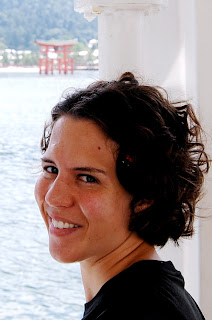
A manhole cover in Miyoshi
Last Sunday, Joe and I decided we needed a break from the city, so we took a day trip to the little town of Miyoshi in the north end of the prefecture.
Half the reason for going was actually just the train ride. We'd heard the Geibi line is very scenic, and indeed it was. The tracks ran across the countryside between towering mountains, past tiny villages and vibrant green rice paddies. From our house it was a two-hour ride, but it passed in no time since we spent the whole trip gazing out the windows.

After we'd arrived and grabbed some lunch at the local "cultural center," which just looked like an ordinary mall, we struck back out into the heat and hunted down a shrine near the train station.


The shrine itself wasn't anything much out of the ordinary, but it was tucked away up on the side of a hill among some tall trees and grassy areas, which was very peaceful. It also gave us a nice view over the city, which has a population of about 60,000 people.
We wandered around town a bit admiring the rice paddies and thoroughly sweated through our clothes in the 90+ heat.



Then came the other half of our reason for visiting Miyoshi — finding the spot on the Basen River where we could see cormorant fishing later that evening.
Cormorant fishing, or ukai, dates back 1,300 years. Miyoshi is one of a handful of places throughout Japan where you can witness this traditional method of fishing on summer evenings. Instead of using fishing poles, these fishermen use specially trained cormorant birds. The fishermen put the birds on leashes and the birds dive under water to catch fish. A harness tied around their neck prevents the birds from actually swallowing the fish, so the fishermen can pull them back to the surface and make them spit the fish out. Poor birds...


You can make reservations to ride the boats and witness the fishing up close, but a fellow teacher who grew up in Miyoshi told me rides are 8,000 yen ($80) per person, which was a bit too steep for Joe and I, even considering that the price included a bento dinner. Now if it was steak, then we could talk about it.
We arrived well before the start of the fishing at 7:30 PM, so we got to watch the fishermen set up their boats, assembling tents over top and stringing Japanese lanterns down the sides.


Soon men and women began showing up in colorful yukata. They took their seats on the boats and ate dinner while the fishermen prepared the birds nearby.

At nightfall, the boats, lanterns lit, pulled away and set off down the river. The boats with passengers rode alongside the boats carrying the birds, and fisherman held large lamps over the birds as they swam so everyone could see them dive down and come up with the fish.


Apparently other places, like Iwakuni, actually use large torches instead of lamps, which I think would be a lot more thrilling.

Joe and I could see the birds diving, but unfortunately we couldn't actually get close enough to see them coughing up any fish. But I got to see the catch after they returned. There were several bins like this.

Hopefully the fishermen treat the birds to a few of these at the end of the night.
It was all quite a spectacle. It's when I see stuff like this that I really feel blessed to be here in Japan, seeing things that most other people don't get to see.
